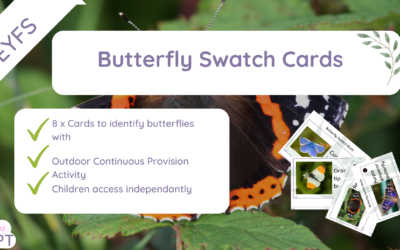What does this resource include? Instruction in how to use 1 x Outdoor Frame How can I use this resource? Cut the...
Minibeast magnifying glasses
Apr 24, 2023
What does this resource include? One magnifying glass with a picture front and words on the back. How can I use this...
Tree Swatch Book
Apr 24, 2023
What does this resource include? 12 x Tree swatch cards of typical trees found in the UK How can I use this resource? ...
Butterfly Swatch Book
Apr 24, 2023
What does this resource include? Eight cards of typical butterflies found in the UK How can I use this resource? Cut...
The MPT Prospectus
Dec 5, 2022
The MPT Prospectus What does this resource include? 1 x 27-page PDF document explaining the services w have at MPT...
Pond Dipping (KS1)
Nov 15, 2022
What does this resource include? 3 x Activity Sheets for Pond Dipping How can I use this resource? Use it as a...
EYFS&KS1: Autumn Outdoor Continuous Provision
Oct 18, 2022
What does this pack include? 1 Vlog giving you tips on how you can use leaves in autumn for outdoor continuous...
Muddy Lanyard Challenges (Art Outdoor Continuous Provision)
May 27, 2022
Use Muddy Lanyard Challenges as part of your continuous provision to help give the children some guidance as they play...
Muddy Lanyard Challenges – 2D and 3D shapes
May 4, 2022
The Muddy Puddle Teachers are all over these Muddy Lanyard Challenges - 2D and 3D shapes, you need some too! A new...
Phase 3 Phonics Sounds in Leaves
May 4, 2022
Use Phase 3 Phonics Sounds in Leaves to add some guided phonics in your tuff spots or alternatively use it as an...
Muddy Lanyard Challenges Doubles to 20
May 4, 2022
Our Muddy Lanyard Challenges Doubles to 20 are a big favourite used as a stand-alone lesson, extension activity or for...
Capital Letters using Leaves (Flashcard)
May 4, 2022
Capital Letters Outdoor Learning. Use Capital Letters using Leaves (Flashcard) on tuff spots with leaves so that...
Subitising Numbers 0-10 (Nature Posters) (Flashcard)
May 4, 2022
Use Subitising Numbers 0-10 (Nature Posters) to gather up loose parts play that will encourage children to add nature...
Muddy Lanyard Challenges Numbers 1- 20
May 4, 2022
Our much-loved Muddy Lanyard Challenges are very popular and a versatile tool to use outdoors, give direction and in...
Numbers in Stones (Tuff Spot/Display)
May 4, 2022
This versatile resource is going to save you time and improve the quality of your outdoor provision. Use on tuff spots...
Numbers in Leaves (Tuff Spot/Display)
May 4, 2022
Time to make early years outdoors a little easier for yourself? These cards are great to give direction for tuff...
Capital Letters in Rocks
Apr 26, 2022
Capital Letters in Rocks this a great nature-based poster set to display in the continuous provision or you could use...
Capital Letters in Leaves
Apr 26, 2022
Capital Letters in Leaves is a super popular resource of ours that could be used in outdoor continuous provision or...
New In

World Bee Day (Babies)

Outdoor Learning Ideas (Ropes) KS1

Outdoor Learning Ideas using Ropes (EYFS)

10 Outdoor Valentines Day Lesson Ideas

10 Outdoor VE Ideas – KS1

10 Outdoor Ideas for VE Day – EYFS

100 Outdoor Learning Ideas

Year 1 Punctuation (Rope Method)

Nature Flash Cards (Outdoor Learning) – Non-Verbal Cue Cards




















